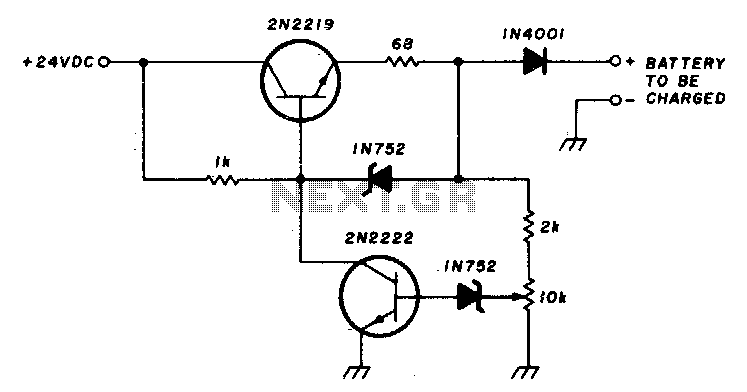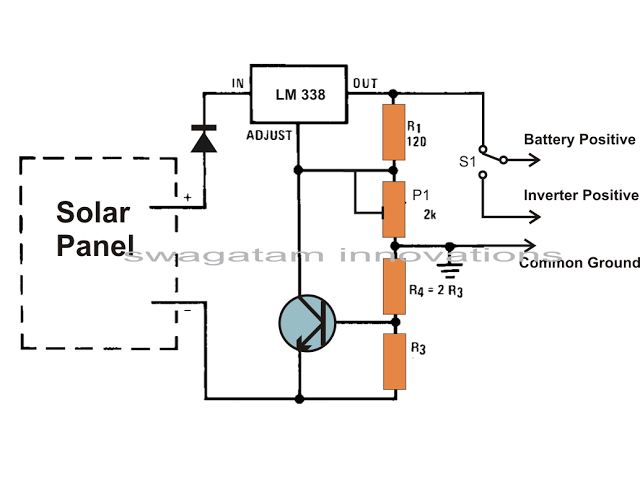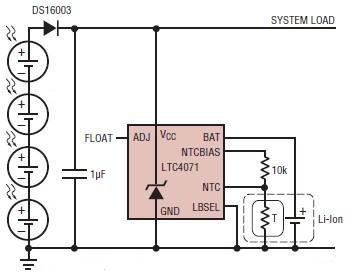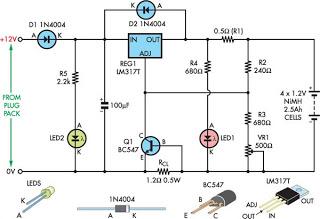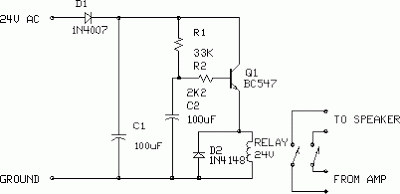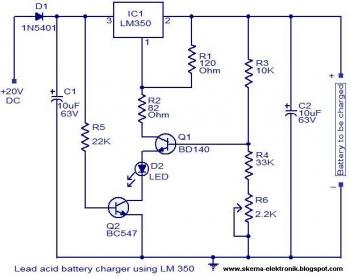
A Friendly Charger Schematic for Mobile Phones
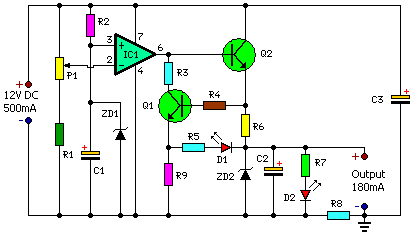
Most mobile chargers lack current and voltage regulation, as well as short-circuit protection. These chargers typically provide unregulated 6-12V DC for charging battery packs, which generally have a rating of 3.6V and 650mAh. To enhance battery life, it is advisable to charge at a low current over a period of six to ten hours at 150-200mA. This circuit provides approximately 180mA at 5.6V and safeguards the mobile phone from unexpected voltage fluctuations on the mains line, allowing the charger to remain connected overnight to recharge the battery. The circuit disconnects the output when it detects a voltage surge or a short circuit in the battery pack or connector, acting as an intermediary between the charger and the mobile phone. It features voltage and current regulation, over-current protection, and high- and low-voltage cut-off. Notably, it includes a ten-second delay before turning on after a power failure to protect against instantaneous voltage spikes. In case of a short circuit at the battery terminal, resistor R8 detects the over-current, enabling Q1 to conduct and illuminate D1. The glowing of D2 signifies the charging mode, while D1 indicates a short-circuit or over-current condition. The value of resistor R8 is crucial for achieving the desired current level for the cut-off, with a value of 3.3 ohms yielding 350mA. The charging current can be adjusted by modifying the value of R7 using the formula I=V/R. The circuit should be constructed on a common PCB and housed in a compact plastic enclosure. It is essential to connect the circuit correctly between the charger output lines and the mobile phone input pins.
The design of this charging circuit is critical for ensuring the longevity and safety of mobile phone batteries. The integration of voltage and current regulation prevents overcharging, which can lead to battery damage or reduced lifespan. By maintaining a charging current of around 180mA, the circuit adheres to the recommended slow charging practices, thereby minimizing heat generation and enhancing battery health.
The over-current protection mechanism is particularly important in scenarios where the battery may develop faults or when there is a short circuit. The use of resistor R8 not only helps in sensing over-current conditions but also plays a crucial role in determining the maximum charging current. Adjusting R7 allows for fine-tuning of the charging current to suit different battery specifications or user preferences.
The inclusion of a ten-second delay before reactivation post power failure is a thoughtful design element that mitigates the risk of damage from voltage spikes. This feature ensures that the mobile phone is not subjected to sudden surges, which could potentially harm its internal circuitry.
In terms of physical construction, utilizing a common PCB allows for a compact design that can easily fit within a small plastic case. This not only makes the circuit portable but also protects the components from environmental factors.
Overall, this circuit serves as an effective solution for mobile charging, providing essential protective features while ensuring efficient battery charging practices. Proper assembly and connection are vital for the successful operation of this circuit, emphasizing the importance of attention to detail in electronic design.Most mobile chargers do not have current/voltage regulation or short-circuit protection. These chargers provide raw 6-12V DC for charging the battery pack. Most of the mobile phone battery packs have a rating of 3. 6V, 650mAh. For increasing the life of the battery, slow charging at low current is advisable. Six to ten hours of charging at 150-200m A current is a suitable option. This will prevent heating up of the battery and extend its life. The circuit described here, provides around 180mA current at 5. 6V and protects the mobile phone from unexpected voltage fluctuations that develop on the mains line. So the charger can be left on` over night to replenish the battery charge. The circuit protects the mobile phone as well as the charger by immediately disconnecting the output when it senses a voltage surge or a short circuit in the battery pack or connector.
It can be called a middle man` between the existing charger and the mobile phone. It has features like voltage and current regulation, over-current protection, and high- and low-voltage cut-off. An added specialty of the circuit is that it incorporates a short delay of ten seconds to switch on when mains resumes following a power failure.
This protects the mobile phone from instant voltage spikes. When short-circuit occurs at the battery terminal, resistor R8 senses the over-current, allowing Q1 to conduct and light up D1. Glowing of D2 indicates the charging mode, while D1 indicates short-circuit or over-current status. The value of resistor R8 is important to get the desired current level to operate the cut-off. With the given value of R8 (3. 3 ohms), it is 350 mA. Charging current can also be changed by increasing or decreasing the value of R7 using the I=V/R` rule.
Construct the circuit on a common PCB and house in a small plastic case. Connect the circuit between the output lines of the charger and the input pins of the mobile phone with correct polarity. We aim to transmit more information by carrying articles. Please send us an E-mail to wanghuali@hqew. net within 15 days if we are involved in the problems of article content, copyright or other problems.
We will delete it soon. 🔗 External reference
The design of this charging circuit is critical for ensuring the longevity and safety of mobile phone batteries. The integration of voltage and current regulation prevents overcharging, which can lead to battery damage or reduced lifespan. By maintaining a charging current of around 180mA, the circuit adheres to the recommended slow charging practices, thereby minimizing heat generation and enhancing battery health.
The over-current protection mechanism is particularly important in scenarios where the battery may develop faults or when there is a short circuit. The use of resistor R8 not only helps in sensing over-current conditions but also plays a crucial role in determining the maximum charging current. Adjusting R7 allows for fine-tuning of the charging current to suit different battery specifications or user preferences.
The inclusion of a ten-second delay before reactivation post power failure is a thoughtful design element that mitigates the risk of damage from voltage spikes. This feature ensures that the mobile phone is not subjected to sudden surges, which could potentially harm its internal circuitry.
In terms of physical construction, utilizing a common PCB allows for a compact design that can easily fit within a small plastic case. This not only makes the circuit portable but also protects the components from environmental factors.
Overall, this circuit serves as an effective solution for mobile charging, providing essential protective features while ensuring efficient battery charging practices. Proper assembly and connection are vital for the successful operation of this circuit, emphasizing the importance of attention to detail in electronic design.Most mobile chargers do not have current/voltage regulation or short-circuit protection. These chargers provide raw 6-12V DC for charging the battery pack. Most of the mobile phone battery packs have a rating of 3. 6V, 650mAh. For increasing the life of the battery, slow charging at low current is advisable. Six to ten hours of charging at 150-200m A current is a suitable option. This will prevent heating up of the battery and extend its life. The circuit described here, provides around 180mA current at 5. 6V and protects the mobile phone from unexpected voltage fluctuations that develop on the mains line. So the charger can be left on` over night to replenish the battery charge. The circuit protects the mobile phone as well as the charger by immediately disconnecting the output when it senses a voltage surge or a short circuit in the battery pack or connector.
It can be called a middle man` between the existing charger and the mobile phone. It has features like voltage and current regulation, over-current protection, and high- and low-voltage cut-off. An added specialty of the circuit is that it incorporates a short delay of ten seconds to switch on when mains resumes following a power failure.
This protects the mobile phone from instant voltage spikes. When short-circuit occurs at the battery terminal, resistor R8 senses the over-current, allowing Q1 to conduct and light up D1. Glowing of D2 indicates the charging mode, while D1 indicates short-circuit or over-current status. The value of resistor R8 is important to get the desired current level to operate the cut-off. With the given value of R8 (3. 3 ohms), it is 350 mA. Charging current can also be changed by increasing or decreasing the value of R7 using the I=V/R` rule.
Construct the circuit on a common PCB and house in a small plastic case. Connect the circuit between the output lines of the charger and the input pins of the mobile phone with correct polarity. We aim to transmit more information by carrying articles. Please send us an E-mail to wanghuali@hqew. net within 15 days if we are involved in the problems of article content, copyright or other problems.
We will delete it soon. 🔗 External reference
